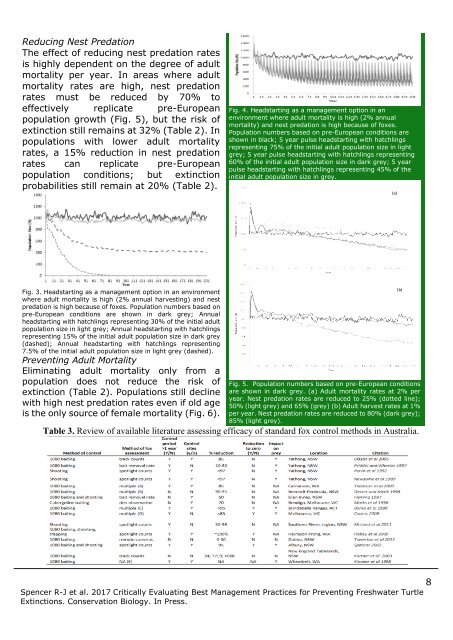Preventing Freshwater Turtle Extinctions
Critically Evaluating Best Management Practices For Preventing Freshwater Turtle Extinctions
Critically Evaluating Best Management Practices For Preventing Freshwater Turtle Extinctions
- No tags were found...
You also want an ePaper? Increase the reach of your titles
YUMPU automatically turns print PDFs into web optimized ePapers that Google loves.
Reducing Nest Predation<br />
The effect of reducing nest predation rates<br />
is highly dependent on the degree of adult<br />
mortality per year. In areas where adult<br />
mortality rates are high, nest predation<br />
rates must be reduced by 70% to<br />
effectively replicate pre-European<br />
population growth (Fig. 5), but the risk of<br />
extinction still remains at 32% (Table 2). In<br />
populations with lower adult mortality<br />
rates, a 15% reduction in nest predation<br />
rates can replicate pre-European<br />
population conditions; but extinction<br />
probabilities still remain at 20% (Table 2).<br />
Fig. 4. Headstarting as a management option in an<br />
environment where adult mortality is high (2% annual<br />
mortality) and nest predation is high because of foxes.<br />
Population numbers based on pre-European conditions are<br />
shown in black; 5 year pulse headstarting with hatchlings<br />
representing 75% of the initial adult population size in light<br />
grey; 5 year pulse headstarting with hatchlings representing<br />
60% of the initial adult population size in dark grey; 5 year<br />
pulse headstarting with hatchlings representing 45% of the<br />
initial adult population size in grey.<br />
(a)<br />
1<br />
Fig. 3. Headstarting as a management option in an environment<br />
where adult mortality is high (2% annual harvesting) and nest<br />
predation is high because of foxes. Population numbers based on<br />
pre-European conditions are shown in dark grey; Annual<br />
headstarting with hatchlings representing 30% of the initial adult<br />
population size in light grey; Annual headstarting with hatchlings<br />
representing 15% of the initial adult population size in dark grey<br />
(dashed); Annual headstarting with hatchlings representing<br />
7.5% of the initial adult population size in light grey (dashed).<br />
<strong>Preventing</strong> Adult Mortality<br />
Eliminating adult mortality only from a 2<br />
population does not reduce the risk of<br />
extinction (Table 2). Populations still decline<br />
with high nest predation rates even if old age<br />
is the only source of female mortality (Fig. 6).<br />
Fig. 5. Population numbers based on pre-European conditions<br />
are shown in dark grey. (a) Adult mortality rates at 2% per<br />
year. Nest predation rates are reduced to 25% (dotted line);<br />
50% (light grey) and 65% (grey) (b) Adult harvest rates at 1%<br />
per year. Nest predation rates are reduced to 80% (dark grey);<br />
85% (light grey).<br />
Table 3. Review of available literature assessing efficacy of standard fox control methods in Australia.<br />
(b)<br />
8<br />
Spencer R-J et al. 2017 Critically Evaluating Best Management Practices for <strong>Preventing</strong> <strong>Freshwater</strong> <strong>Turtle</strong><br />
<strong>Extinctions</strong>. Conservation Biology. In Press.


